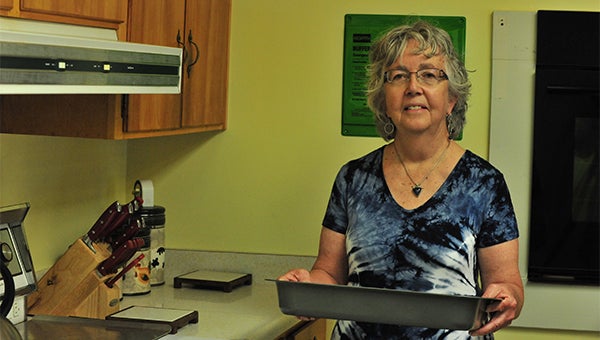County residents can learn to shop, eat, live with health in mind
Published 10:00 pm Friday, October 21, 2016

Jimmi Buell is pictured in the kitchen at the Polk County Cooperative Extension office where she gives cooking, food preservation, and healthy living classes.
It’s no secret that diabetes and obesity are rising in the country, with tragic health and financial consequences.
Dietary and exercise recommendations are also not secret, though many individuals are apparently confused about what choices to make. Locally, Jimmi Buell, through the Polk County Cooperative Extension office, is helping many residents learn how to shop and cook in a more healthy way.
Buell is the county’s family consumer science agent, with eight years of experience. Each county’s cooperative extension office operates under North Carolina State University, the state’s land grant university.
With prior experience in public health in Haywood County, Buell has the background. As a bicycling enthusiast, she also has the personal experience, including the benefits of regular exercise and healthy eating, to help reach the public.
“My area of focus is health, nutrition and chronic disease prevention,” Buell says. “I work with youth, as well as with adults.”
She offers programs in nutrition, wellness and cooking. Conveniently, the Cooperative Extension office, located at Gibson and Ward streets in Columbus, is housed in a building with a good kitchen.
Buell feels that her own exercise program influences what she teaches, regarding a healthy combination of physical activity and nutrition. She notes that if one looks at any diet recommendations, they all emphasize the importance of physical exercise.
“Everything I teach is research based,” she continues. “I don’t teach fad diets.”
In agriculture-based populations, farmers worked hard before the first meal of the day—a large breakfast. Dinner, eaten around mid-day, was also a large meal, while supper was the smallest meal of the day. Farmers got lots of exercise and ate much produce.
“They didn’t have the junk foods,” Buell adds.
“The most important part of the meal is from around the perimeter of the grocery store,” Buell advises residents. That’s where consumers will find produce, dairy and meat, fish and poultry choices.
Something else that has changed from 50 years ago, is that you didn’t eat three meals a day at fast-food establishments. Dining there was more of a special-occasion experience, while now, such establishments often see the same customers often, Buell says.
“We’ve been successful,” Buell says, in connecting with clients.
Among the classes Buell teaches is one from Stanford University, Living Healthy with a Chronic Disease (like diabetes type 2).
“A lot of people don’t realize there’s more than taking the medication. It’s more or less how you live your life daily with chronic disease,” she says.
While many individuals have been frightened by some general advice on carbohydrates, Buell notes that many folks can consume up to 65 grams of carbohydrates daily.
She also noted the importance of choosing foods lower on the scale of glycemic index (how carbohydrate foods affect blood glucose levels)—for instance going easy on white rice and white flour.
Often, Buell notes, “It’s about what foods are triggers (for negative reactions). Everybody’s body chemistry is different.” She notes that clients must figure these specifics themselves.
Buell noted that the position she fills began some 30 years ago.
“I continue to update it,” she says. “For instance, over the past 15 to 20 years, the Mediterranean Diet has gained considerable popularity and credibility. Such a diet is high in vegetables and healthy fats from olive oil, nuts and fish, and contains moderate amounts of protein.”
Buell notes that research shows the Mediterranean diet has been the most effective in reducing chronic disease. She recommends eating fish at least once or twice weekly, with red meat consumption limited to once or twice monthly.
Regarding exercise and diet, Buell cautions that, “You can’t simply be active, and eat whatever you want.”
Classes vary, Buell says, depending on what the community needs.
Classes on diabetes are given some three times per year, with men’s cooking usually given once a year. Classes in home preservation (canning/storing of fresh foods) are taught about three times annually.
Buell is also certified to teach classes in food safety, for which restaurants are tested. Issues include cross-contamination, proper storage of food, and cooking at proper temperatures. Such classes are given through NC State University, which has a food safety department.
In addition to these efforts, Buell works with the Supplemental Nutrition Assistance Program – Education (SNAP-Ed) in local schools where she teaches healthy eating, and gives samples of healthy food for students to try.
Many individuals have trouble getting children to eat vegetables, more so than with fruit, Buell acknowledges. Even if children end up not liking certain choices, Buell gets them to try many things new for them.
She also notes that while many children are picky eaters, reaching puberty often changes that, with the same people broadening their choices and acceptance.
Buell is also involved with the Polk Fit, Fresh and Friendly (PF3) program, a health incentive separate from the Cooperative Extension.
“It’s a community health coalition,” Buell says. The PF3 board meets monthly. Every two months, the board holds meetings open to the general public.
To learn more about Buell’s classes or PF3, contact her through the Polk County Cooperative Extension office at 828-894-8218.





